|
|
|
Sort Order |
|
|
|
Items / Page
|
|
|
|
|
|
|
| Srl | Item |
| 1 |
ID:
131024
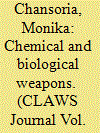

|
|
|
|
|
| Publication |
2014.
|
| Summary/Abstract |
In a March 2014 report, the United Nations human rights investigators con?rmed that chemical weapons were indeed used in Syria in 2013, which apparently came from the stockpiles of the Syrian military, whose chemical weapons stash reportedly included mustard gas. The report con?rmed that the deadly nerve agent Sarin was used in three separate incidents: the Damascus suburb ofal-Ghouta in August 2013, Khan al-Assal in March 2013 and Saraqeb near the northern town of ldlih in April 2013. While the Bashar al-Assad government and the Syrian opposition indict each other of using chemical weapons, which are strictly banned as per existing international law and convention, the incidents amount to being the deadliest chemical attacks the world has witnessed in almost a quarter of a century.
|
|
|
|
|
|
|
|
|
|
|
|
|
|
|
|
| 2 |
ID:
133690
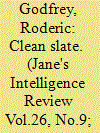

|
|
|
|
|
| Publication |
2014.
|
| Summary/Abstract |
As Syria's declared chemical weapons are destroyed, Roderic Godfrey assesses whether their destruction has stopped the Syrian regime from contravening its new international obligations, and the dilemma faces by the international community.
|
|
|
|
|
|
|
|
|
|
|
|
|
|
|
|
| 3 |
ID:
130711


|
|
|
|
|
| Publication |
2014.
|
| Summary/Abstract |
A range of hazardous organic and inorganic compounds, and metal ions generated by human and industrialactivities leads to serious concerns for environments. Adsorption technologies based on polymeric materials are beingused to remove toxic substances from air and wastewater streams. Keratin protein, found abundantly in sheep's wool,human hair and bird feathers, is an interesting and potentially useful renewable biopolymer. It contains a variety offunctional groups on the backbone and side chains of the proteins, and is an ideal component to fabricate a rangeof novel adsorbent systems for separation of toxic pollutants via physisorption or chemisorption mechanisms. Inthis review article, the key activities on keratin research and development with respect to the novel properties ofkeratin proteins and their utilization as absorbents or filtration systems are summarized. It is apparent that keratinsin the form of loose fibers, non-woven fabrics, short fibers or particles, membranes and colloids can be used as absorbents for air filtration and wastewater treatment. Keratin materials have potential to be applied in biological and chemical defence applications, and also in protection against radioactive elements.
|
|
|
|
|
|
|
|
|
|
|
|
|
|
|
|
| 4 |
ID:
134205
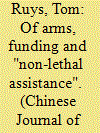

|
|
|
|
|
| Publication |
2014.
|
| Summary/Abstract |
In spite of legal objections, the European Union (EU) in May 2013 gave the conditional green light for the transfer of arms to the Syrian Opposition Council. The EU's decision is not a solitary move. Several other States, including Russia, the United States, Qatar and Saudi Arabia, have provided arms, funding and/or "non-lethal assistance" either to the Syrian government or to rebel forces combatting the Assad regime. The present contribution aims to shed light on the legality of such assistance. On the one hand, it assesses legal objections related to the fact that third-State assistance is used for the commission of widespread war crimes and human rights violations. On the other hand, it examines the compatibility of such assistance with the non-intervention principle and, in so doing, examines to what extent the latter principle discriminates between de jure governments and non-State armed groups in the context of a civil war.
|
|
|
|
|
|
|
|
|
|
|
|
|
|
|
|
| 5 |
ID:
132204


|
|
|
|
|
| Publication |
2014.
|
| Summary/Abstract |
Recent studies have taken an important first step in examining which terrorist groups, based on their organizational characteristics and the characteristics of the environment in which they operate, are more likely to pursue chemical, biological, radiological, and nuclear (CBRN) weapons. This approach, however, assumes that individuals who perpetrate events act on behalf of the organization to which they primarily belong. Using the case of Jemaah Islamiyah's alleged attempt to develop the pathogenic bacterium Bacillus anthracis, or anthrax, the authors demonstrate the importance of including individual-level variables to the analysis. In particular, the attendance by several key Jemaah Islamiyah members at an Al Qaeda-affiliated training camp is argued to set a chain of events into motion that ended in their involvement in the anthrax cultivation program.
|
|
|
|
|
|
|
|
|
|
|
|
|
|
|
|
| 6 |
ID:
131443
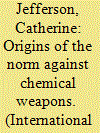

|
|
|
|
|
| Publication |
2014.
|
| Summary/Abstract |
The use of chemical weapons in Syria in August 2013 led to calls for a tough international response in order to uphold the norm against what is often portrayed as a particularly odious form of warfare. The condemnation of poison weapons has a long history and this article examines the origins of the international norm against their use. It focuses particularly on the proceedings of the first Hague Peace Conference and suggests that this represented the emergence of an important distinction between the customary norm against poison and poisoned arms, and a newly codified norm against the use of asphyxiating gas projectiles, which was primarily an attempt to limit the potential of new weapons technologies. However, psychological responses to the wide-scale use of chemical weapons in the First World War underscored a deep revulsion to this form of warfare and blurred the distinction between gas projectiles and poison. While the Hague Conventions ultimately failed to avert the use of chemical weapons, the formation of the 1925 Geneva Protocol reaffirmed the norm against the use of poison in war and represented both a legal and moral condemnation of chemical and biological weapons that continues to be enshrined in international law today.
|
|
|
|
|
|
|
|
|
|
|
|
|
|
|
|
| 7 |
ID:
124999
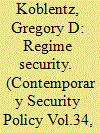

|
|
|
|
|
| Publication |
2013.
|
| Summary/Abstract |
The literature on the proliferation of chemical and biological weapons (CBW) emphasizes the role of external security threats as the primary motive for states to acquire and use these weapons. As recent events in Syria demonstrate, governments lacking political legitimacy may use these weapons to repress domestic challenges to their rule. The concept of regime security provides a theoretical framework for understanding how the threat of military coups, insurgencies, or domestic rivals influences the acquisition and use of CBW by authoritarian regimes. The cases of South Africa and Iraq illustrate how a government's concerns about internal security threats can impact its CBW proliferation decision-making. Omitting regime security as a factor in CBW decision-making may lead to the adoption of inappropriate nonproliferation and deterrent strategies. In light of Syrian President Bashar al-Assad's use of chemical weapons against his own people, developing a deeper understanding of the influence of regime security on the acquisition and use of chemical and biological weapons should be a priority.
|
|
|
|
|
|
|
|
|
|
|
|
|
|
|
|
| 8 |
ID:
131609


|
|
|
|
|
| Publication |
2014.
|
| Summary/Abstract |
The effort to destroy Syria's chemical weapons program made little visible progress in May as none of the chemical weapons materials remaining in Syria were shipped out of the country for destruction.
Also last month, a team from the Organisation for the Prohibition of Chemical Weapons (OPCW) investigating allegations of chlorine attacks in Syria had to turn back from the site it was investigating and return to Damascus after it came under assault.
Under a schedule set last November by the OPCW Executive Council, the highest-priority chemicals among Syria's declared stockpile of 1,300 metric tons were to be shipped out of the country by Dec. 31 for destruction elsewhere. Most lower-priority materials were to be out by Feb. 5, and Syria was to destroy the rest of the material domestically
|
|
|
|
|
|
|
|
|
|
|
|
|
|
|
|
| 9 |
ID:
128056


|
|
|
|
|
| Publication |
2013.
|
| Summary/Abstract |
Preventing further use of chemical weapons in Syria will be achieved by their elimination rather than punitive airstrikes. Selective airstrikes, as repeatedly threatened by France, the United Kingdom, and the United States, would not have altered the military situation in the civil war, as the Syrian opposition forces and their backers had hoped.The airstrikes would most certainly not have degraded Syria's chemical weapons capacity to the point it would have become useless, and further chemical attacks would have remained a distinct possibility. Targeting chemical weapons storage sites risked releasing toxic clouds affecting combatants and noncombatants alike. Destroying other types of targets would have just added to the tally of conventional weapons casualties
|
|
|
|
|
|
|
|
|
|
|
|
|
|
|
|
| 10 |
ID:
133344
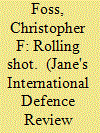

|
|
|
|
|
| Publication |
2014.
|
| Summary/Abstract |
Russia's replacement for the 152MM 253 self propelled (SP) artillery system, the 2S19, has become a very solid seller, with an estimated 650+ now built for the home and export markets.
|
|
|
|
|
|
|
|
|
|
|
|
|
|
|
|
| 11 |
ID:
130372
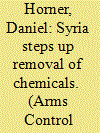

|
|
|
|
|
| Publication |
2014.
|
| Summary/Abstract |
Syria has picked up the pace in removing its chemical weapons materials for overseas destruction and has sent about half of its stockpile out of the country, according to figures in a March 20 press release from the Organisation for the Prohibition of Chemical Weapons (OPCW). Syria had been under broad international pressure to speed up the effort. By the end of February, it had made four shipments, removing about 5 percent of its so-called Priority 1 chemicals and about 20 percent of the Priority 2 chemicals. Citing those figures, Robert Mikulak, the U.S. ambassador to the OPCW, had accused Syria of "continu[ing] to drag its feet." (See ACT, March 2014.) Under a schedule set last November by the OPCW Executive Council, the Priority 1 materials were supposed to leave the country by Dec. 31. All other materials that are part of the overseas destruction program were to leave by Feb. 5. The rest of the approximately 1,300 metric tons of chemical agents that Syria declared is to be destroyed within the country. The removal dates were set with an eye to a June 30 deadline for destruction of the chemical agents, which was established last September by the Executive Council and the UN Security Council. (See ACT, October 2013.)
|
|
|
|
|
|
|
|
|
|
|
|
|
|
|
|
| 12 |
ID:
129110
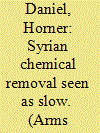

|
|
|
|
|
| Publication |
2014.
|
| Summary/Abstract |
Amid increasing frustration over the pace of Syria's removal of chemical weapons materials for overseas destruction, Syrian authorities are in talks with key countries and experts from the Organisation for the Prohibition of Chemical Weapons (OPCW) and the United Nations on a revised timetable for the removal effort, according to media reports and spokesmen for some of the parties in the negotiations. Syria has proposed a timetable that would take until about the end of May, but the U.S. government "believes that the Syrians are more than capable of moving these chemicals to Latakia on a shorter timetable," a State Department spokesman said in a Feb. 28 e-mail to Arms Control Today. Latakia is the port city in northwestern Syria where the Syrian government is collecting the chemicals from across the country before sending them overseas for destruction.
|
|
|
|
|
|
|
|
|
|
|
|
|
|
|
|
| 13 |
ID:
130864
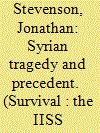

|
|
|
|
|
| Publication |
2014.
|
| Summary/Abstract |
If Washington's Syria policy succeeds, it will crystallise efforts to privilege diplomacy over the use of force and create a precedent other powers will be apt to follow. The United States' present Syria policy is perhaps the most vivid, and discomfiting, example of the Obama administration's realism. Its military forbearance, even in the face of a burgeoning humanitarian crisis (over 150,000 Syrians have died in just over three years) and the Assad regime's use of chemical weapons, has been resolute. Its focus on using diplomacy instead of military power has been firm, if vexing. These traits suggest three strategic clean breaks from the George W. Bush administration's post-9/11 policy. Firstly, they imply recognition by the US that major wars remain possible and cannot be subordinated to 'small wars' of choice. Secondly, they indicate that the counter-insurgency tools developed for expeditionary deployments to Iraq and Afghanistan have been rejected as instruments of policy. Thirdly, they subsume a determined effort at rapprochement with Iran and, more broadly, an approach to Middle Eastern affairs that is substantially less confrontational and heavy-handed.
|
|
|
|
|
|
|
|
|
|
|
|
|
|
|
|
| 14 |
ID:
133622
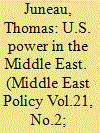

|
|
|
|
|
| Publication |
2014.
|
| Summary/Abstract |
It has become common to hear that American power in the Middle East is waning. The recent U.S.-Russia deal on the elimination of Syria's chemical-weapons program, for example, has even led some to talk of U.S. weakness in the region.2 This article instead argues that American power in the Middle East is not declining but is, in fact, slightly increasing, due principally to U.S. military domination, the strong positions of its regional partners and the stagnation or decline of its rivals. It is true that U.S. ambition in the Middle East is diminishing, albeit only slightly. This is distinct, however, from power. A pronounced and durable decrease in U.S. regional ambition, moreover, is not sustainable. Because of structural pressures, it is difficult for the United States to more than marginally reduce its regional presence. It is not losing its grip on the Middle East but trying, with only partial success, to loosen it.3
|
|
|
|
|
|
|
|
|
|
|
|
|
|
|
|
| 15 |
ID:
127861


|
|
|
|
|
| Publication |
2013.
|
| Summary/Abstract |
The United States will destroy Syria's most dangerous chemical weapons, using a mobile technology on board a ship, officials from the international team that is overseeing Syrian chemical disarmament said late last month. In a Nov. 30 press release, the Organisation for the Prohibition of Chemical Weapons (OPCW) said the operations would be conducted "on a U.S. vessel at sea using hydrolysis," a process that breaks down the chemical agent with hot water and a caustic compound such as sodium hydroxide. Hydrolysis is a type of neutralization, which, along with incineration, is one of the two main methods of destroying chemical weapons.
|
|
|
|
|
|
|
|
|
|
|
|
|
|
|
|
|
|
|
|
|